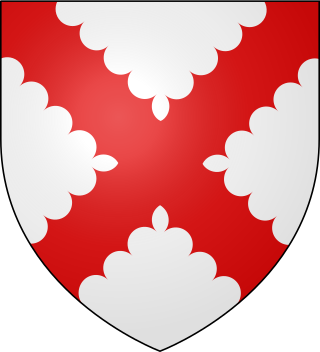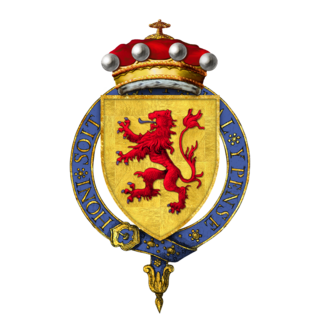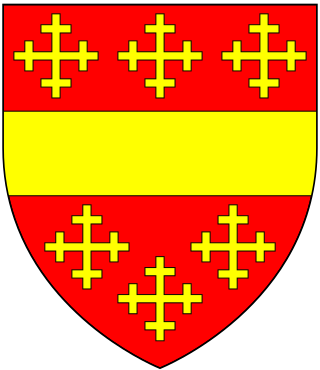
Sir Robert Wingfield, of Letheringham in Suffolk, was an English landowner, administrator and politician.

The barony of Camoys was created twice. From 26 November 1313 to 1 April 1335 Ralph de Camoys (d.1336) was summoned to Parliament by writ, and is thereby held to have become Baron Camoys of the first creation. Ralph de Camoys (d.1336) married firstly, Margaret de Brewes, daughter of William de Brewes, 1st Lord Brewes (d.1291), and secondly, Elizabeth le Despenser, daughter of Hugh le Despenser, 1st Earl of Winchester.

Baron Strange is a title which has been created four times in the Peerage of England. Two creations, one in 1295 and another in 1326, had only one holder each, upon whose deaths they became extinct. Two of the creations, that of 1299 and that of 1628, are extant. The surname Le Strange was Latinized as Extraneus. The arms of Le Strange of Knockin Castle in Shropshire were: Gules, two lions passant argent.

John Tiptoft, 1st Baron Tiptoft was a Knight of the Shire for Huntingdonshire and Somerset, Speaker of the House of Commons, Treasurer of the Household, Chief Butler of England, Treasurer of the Exchequer and Seneschal of Landes and Aquitaine.

Powys Wenwynwyn or Powys Cyfeiliog was a Welsh kingdom which existed during the high Middle Ages. The realm was the southern portion of the former princely state of Powys which split following the death of Madog ap Maredudd of Powys in 1160: the northern portion (Maelor) went to Gruffydd Maelor and eventually became known as Powys Fadog; while the southern portion (Cyfeiliog) going to Owain Cyfeiliog and becoming known, eventually, as Powys Wenwynwyn after Prince Gwenwynwyn ab Owain, its second ruler.

Baron Tibetot is an abeyant title in the Peerage of England. It was created on 10 March 1308 as a barony by writ. It fell into abeyance in 1372. These were the immediate descendants of the crusader Sir Robert de Tiptoft and his wife Eva de Chaworth, early benefactors of the house of Ipswich Greyfriars.

John Tiptoft, 1st Earl of Worcester KG, was an English nobleman and scholar who served as Lord High Treasurer, Lord High Constable of England and Lord Deputy of Ireland. He was known as "the Butcher of England" to his Tudor detractors.
Gruffydd ap Gwenwynwyn was a Welsh king who was lord of the part of Powys known as Powys Wenwynwyn and sided with Edward I in his conquest of Wales of 1277 to 1283.

The title Baron Grey of Powis (1482–1552) was created for the great-grandson of Joan Charleton, co-heiress and 6th Lady of Powis (Powys) and her husband, Sir John Grey, 1st Earl of Tankerville (1384–1421) after the death of Joan's father, Edward Charleton, 5th Baron Cherleton (1370–1421) left the title in abeyance.
Owen de la Pole, also known as Owain ap Gruffydd ap Gwenwynwyn, was the heir presumptive to the Welsh principality of Powys Wenwynwyn until 1283 when it was abolished by the Parliament of Shrewsbury. He became the 1st Lord of Powis after the death of his father Gruffydd ap Gwenwynwyn c. 1287. He is not related to the English de la Pole family descended from William de la Pole, Chief Baron of the Exchequer in the following century, later Earls and Dukes of Suffolk.

Baron FitzWarin was a title in the Peerage of England created by writ of summons for Fulk V FitzWarin in 1295. His family had been magnates for nearly a century, at least since 1205 when his grandfather Fulk III FitzWarin obtained Whittington Castle near Oswestry, which was their main residence and the seat of a marcher lordship.
Sir William de la Pole was the fourth son of Gruffydd ap Gwenwynwyn and would have inherited the principality of Powys Wenwynwyn, if it had continued to descend in the male line according to Welsh law, instead of having been surrendered to Edward I and regranted to his father as a marcher lordship. This descended to William's elder brother Owen de la Pole, and after the death of his son without issue to his daughter Hawise Gadarn, Lady of Powys, wife of John Charleton, 1st Baron Cherleton. Contrary to a few reports, there is no evidence of any relationship to William de la Pole of Hull, merchant and financier to Edward III.

John Charlton, 1st Baron Charlton of Powys (1268–1353) came from a family of minor landowners near Wellington, Shropshire. He was the son of Robert Charlton of Apley castle near Wrockwardine.

Edward Charlton, 5th Baron Charlton, KG (1370–1421), 5th and last Lord Charlton of Powys, was the younger son of John Charlton, the third baron, and his wife, Joan, daughter of Lord Stafford.

The Royal House of Mathrafal began as a cadet branch of the Welsh Royal House of Dinefwr, taking their name from Mathrafal Castle, their principal seat and effective capital. They effectively replaced the House of Gwertherion, who had been ruling the Kingdom of Powys since late Roman Britain, through the politically advantageous marriage of an ancestor, Merfyn the Oppressor. His son, King Bleddyn ap Cynfyn, would join the resistance of the Anglo-Saxon King Harold Godwinson, against the invasion of William the Conqueror, following the Norman conquest of England. Thereafter, they would struggle with the Plantagenets and the remaining Welsh Royal houses for the control of Wales. Although their fortunes rose and fell over the generations, they are primarily remembered as Kings of Powys and last native Prince of Wales.

John Grey, 1st Earl of Tankervillejure uxoris6th Lord of Powys, KG, was an English peer who served with distinction in the Hundred Years' War between England and France under King Henry V.

William III de Beauchamp of Elmley Castle in Worcestershire, was an English Baron and hereditary Sheriff of Worcestershire.
Hon. Sir Edward Herbert was an English politician and landowner. His aunt, Katherine Parr, was the sixth, and final, wife of King Henry VIII.
Hawys Gadarn (Hawys ferch Owain ap Gruffudd ap Gwenwynwyn), also known as the Hardy, the Powerful, the Intrepid, and Hawise de la Pole, (1291 – c. 1353) was the daughter of Owen de la Pole and the heir to Powys Wenwynwyn in Wales. She was married to John Charleton after seeking the intervention of Edward II of England to support her inheritance against the schemes of four of her uncles to take her lands.
John III Lestrange, of Knockin in Shropshire, landowner, administrator and soldier, was a marcher lord defending England along its border with Wales.













